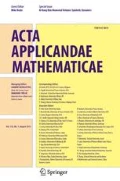Abstract
This paper puts forward a new KAM theorem for the hyperbolic lower dimensional tori in reversible system without assuming any non-degeneracy condition, which can be viewed as a unified form under all kinds of non-degenerate conditions, including Kolmogorov, Bruno and Rüssmann non-degeneracy condition. The theorem with some non-degeneracy conditions not only includes many previous achievements on KAM theory in reversible systems, but also gives some interesting results on the persistence of hyperbolic lower dimensional invariant tori with prescribed frequency in reversible system.
Similar content being viewed by others
References
Arnold, V.I.: Reversible systems. In: Nonlinear and Turbulent Processes in Physics, Kiev, 1983, vol. 3, pp. 1161–1174. Harwood Academic, Chur (1984)
Broer, H.W., Huitema, G.B., Sevryuk, M.B.: Quasi-Periodic Motions in Families of Dynamical Systems, Order Amidst Chaos. Lecture Notes in Math., vol. 1645. Springer, Berlin (1996)
Broer, H.W., Huitema, G.B.: Unfoldings of quasi-periodic tori in reversible systems. J. Dyn. Differ. Equ. 7, 191–212 (1995)
Broer, H.W., Hoo, J., Naudot, V.: Normal linear stability of quasi-periodic tori. J. Differ. Equ. 232, 355–418 (2007)
Broer, H.W., Ciocci, M.C., Hanßmann, H., Vanderbauwhede, A.: Quasi-periodic stability of normally resonant tori. Physica D 238, 309–318 (2009)
Broer, H.W., Ciocci, M.C., Hanßmann, H.: The quasi-periodic reversible Hopf bifurcation. Int. J. Bifurc. Chaos Appl. Sci. Eng. 17, 2605–2623 (2007)
Hanßmann, H.: Quasi-periodic bifurcations in reversible systems. Regul. Chaotic Dyn. 16, 51–60 (2011)
Liu, B.: On lower dimensional invariant tori in reversible systems. J. Differ. Equ. 176, 158–194 (2001)
Lu, X., Xu, J.: Invariant tori with prescribed frequency for nearly integrable Hamiltonian systems. J. Math. Phys. 55, 082702 (2014). doi:10.1063/1.4886476
Moser, J.: Convergent series expansions for quasi-periodic motions. Math. Ann. 169, 136–176 (1967)
Moser, J.: Stable and Random Motions in Dynamical Systems, with Special Emphasis on Celestial Mechanics. Annals Mathematics Studies, vol. 77. Princeton University Press, Princeton (1973)
Kong, Y., Xu, J.: Persistence of lower dimensional hyperbolic tori for reversible system. Appl. Math. Comput. 236, 408–421 (2014)
Parasyuk, I.O.: Conservation of quasiperiodic motions in reversible multifrequency systems. Dokl. Akad. Nauk Ukr. SSR, Ser. A. 9, 19–22 (1982)
Pöschel, J.: On elliptic lower-dimensional tori in Hamiltonian systems. Math. Z. 202, 559–608 (1989)
Pöschel, J.: A lecture on the classical KAM theorem. In: Katok, A., de la Llave, R., Pesin, Ya., Weiss, H. (eds.) Smooth Ergodic Theory and Its Applications, AMS Summer Research Institute, Seattle, 1999. Proc. Symposia in Pure Mathematics, vol. 69, pp. 707–732. Am. Math. Soc., Providence (2001)
Sevryuk, M.B.: Reversible Systems. Lecture Notes in Math., vol. 1211. Springer, Berlin (1986)
Sevryuk, M.B.: Invariant m-dimensional tori of reversible systems with phase space of dimension greater than 2m. J. Sov. Math. 51, 2374–2386 (1990)
Sevryuk, M.B.: New results in the reversible KAM theory. In: Kuksin, S.B., Lazutkin, V.F., Pöschel, J. (eds.) Seminar on Dynamical Systems, pp. 184–199. Birkhäuser, Basel (1994)
Sevryuk, M.B.: The iteration-approximation decoupling in the reversible KAM theory. Chaos 5, 552–565 (1995)
Sevryuk, M.B.: Partial preservation of frequencies in KAM theory. Nonlinearity 19, 1099–1140 (2006)
Tkhai, V.N.: Reversibility of mechanical systems. J. Appl. Math. Mech. 55, 461–468 (1991)
Wang, X., Xu, J.: Gevrey-smoothness of invariant tori for analytic reversible systems under Rüssmann’s non-degeneracy condition. Discrete Contin. Dyn. Syst., Ser. A 25, 701–718 (2009)
Wang, X., Xu, J., Zhang, D.: Persistence of lower dimensional elliptic invariant tori for a class of nearly integrable reversible systems. Discrete Contin. Dyn. Syst., Ser. B 14, 1237–1249 (2010)
Wang, X., Zhang, D., Xu, J.: Persistence of lower dimensional tori for a class of nearly integrable reversible systems. Acta Appl. Math. 115, 193–207 (2011)
Wang, X., Zhang, D., Xu, J.: On the persistence of lower-dimensional elliptic tori with prescribed frequencies in reversible systems. Discrete Contin. Dyn. Syst. 36, 1677–1692 (2016)
Wang, X., Xu, J., Zhang, D.: Degenerate lower dimensional tori in reversible systems. J. Math. Anal. Appl. 387, 776–790 (2012)
Wang, X., Xu, J., Zhang, D.: On the persistence of degenerate lower-dimensional tori in reversible systems. Ergod. Theory Dyn. Syst. 35, 2311–2333 (2015). doi:10.1017/etds.2014.34
Wei, B.: Perturbations of lower dimensional tori in the resonant zone for reversible systems. J. Math. Anal. Appl. 253, 558–577 (2001)
Whitney, H.: Analytic extensions of differentiable functions defined in closed sets. Trans. Am. Math. Soc. 36, 63–89 (1934)
Xu, J.: Normal form of reversible systems and persistence of lower dimensional tori under weaker nonresonance conditions. SIAM J. Math. Anal. 36, 233–255 (2004)
Xu, J., Lu, X.: General KAM theorems and their applications to invariant tori with prescribed frequencies. arXiv:1504.00726 [math.DS]
Acknowledgements
The authors are very grateful to the referees for their many helpful suggestions for this revised version.
Author information
Authors and Affiliations
Corresponding author
Additional information
The first author is supported by National Natural Science Foundation of China (11501234) and Qing Lan Project. The second author is supported by National Natural Science Foundation of China (11371090). The third author is supported by National Natural Science Foundation of China (11001048).
Appendix
Appendix
In this section we formulate a lemma which have been used in the previous section. Let \(\mathcal{B}_{s}\) denote the space of all real analytic functions \(f(x)\) defined in the complex domain \(D(s)=\{x:|\operatorname{Im} x|\leq s\}\); that is
Then it is easy to see that \(\mathcal{B}_{s} \) is a Banach space.
Lemma 2
Let \(\lambda_{1}(\xi),\ldots,\lambda_{2p}(\xi) \) be eigenvalues of the matrix \(\varOmega(\xi) \) such that
Then, there exists a sufficiently small \(\epsilon_{0}\) depending only on \(\varOmega\) such that for any \(\tilde{\varOmega}(x)\in\mathcal{B}_{s}\), \(g(x)\in\mathcal{B}_{s}\), if \(\|\tilde{\varOmega} \|^{\alpha}_{\mathcal{O}\times D(s,r) }\leq \epsilon_{0}\), the equation
has a solution \(f(x)\in\mathcal{B}_{s}\) with
where the constant \(c\) depends only on \(\varOmega\).
For this lemma, we refer to Lemma 3.2 in [24].
Rights and permissions
About this article
Cite this article
Wang, X., Xu, J. & Zhang, D. A New KAM Theorem for the Hyperbolic Lower Dimensional Tori in Reversible Systems. Acta Appl Math 143, 45–61 (2016). https://doi.org/10.1007/s10440-015-0027-0
Received:
Accepted:
Published:
Issue Date:
DOI: https://doi.org/10.1007/s10440-015-0027-0


